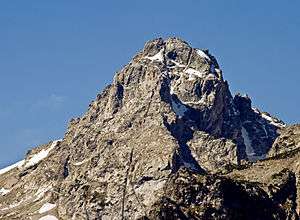Middle Teton
Middle Teton (12,809 feet (3,904 m)) is the third highest peak in the Teton Range, Grand Teton National Park, Wyoming.[3] The peak is immediately southwest of Grand Teton and the two are separated from one another by the lower saddle, a broad high ridge at 11,600 feet (3,540 m). The Middle Teton Glacier is located on the eastern slopes of the peak. Middle Teton is a classic pyramidal shaped alpine peak and is sometimes included as part of the Cathedral Group of high Teton peaks. The 40-mile (64 km) long Teton Range is the youngest mountain chain in the Rocky Mountains, and began their uplift 9 million years ago, during the Miocene.[4] Several periods of glaciation have carved Middle Teton and the other peaks of the range into their current shapes.[5] From the lower saddle, a distinctive feature known as the black dike appears as a straight line running from near the top of the mountain down 800 feet (240 m).[6] The black dike is a basaltic intrusion that occurred long after the surrounding rock was formed.[5]
| Middle Teton | |
|---|---|
 Middle Teton | |
| Highest point | |
| Elevation | 12,809 ft (3,904 m) [1] |
| Prominence | 1,124 ft (343 m) [1] |
| Coordinates | 43°43′48″N 110°48′41″W [2] |
| Geography | |
 Middle Teton Location in Wyoming  Middle Teton Location in the United States | |
| Location | Grand Teton National Park, Teton County, Wyoming, U.S. |
| Parent range | Teton Range |
| Topo map | USGS Middle Teton |
| Climbing | |
| First ascent | 29 August 1923 (Ellingwood) |
| Easiest route | Scramble/snow/class 3/4 |
Climbing
The first recorded ascent of Middle Teton was by Albert R. Ellingwood on August 23, 1923, via Ellingwood Couloir on the south side of the peak. Ellingwood made the first ascent of South Teton the same day.[5]
What is known as the southwest couloir provides the easiest route to the summit. Other sections on the mountain are rated as high as class 5.11, with the Middle Teton Glacier route considered to be the most technically advanced. The first ascent of the Glacier Route was completed on August 4, 1944, by Paul Bradt and Sterling Hendricks. This route is described as a "classic", and is one of the few early season purely ice and snow routes in the Teton Range.[7][8]
See also
References
- "Middle Teton, Wyoming". Peakbagger.com. Retrieved 2011-05-28.
- "Middle Teton". Geographic Names Information System. United States Geological Survey. Retrieved 2011-05-28.
- Grand Teton, WY (Map). TopoQwest (United States Geological Survey Maps). Retrieved 2011-05-28.
- "Mountain Uplift". Creation of the Teton landscape: Geologic story of Grand Teton National Park. National Park Service. Retrieved 2011-05-28.
- Jackson, Reynold G. "Chapter 16: Park of the Matterhorns". A Place Called Jackson Hole. National Park Service. Retrieved 2011-05-28.
- "Middle Teton". SummitPost.org. Retrieved 2011-05-28.
- Rossiter, Richard (1994). Teton Classics: 50 Selected Climbs in Grand Teton National Park. Globe Pequot Press. pp. 24–25. ISBN 9780934641715.
- Ortenburger, Leigh (1996). A Climber's Guide to the Teton Range. Seattle: The Mountaineers Books. pp. 140, 145. ISBN 9781594854330.